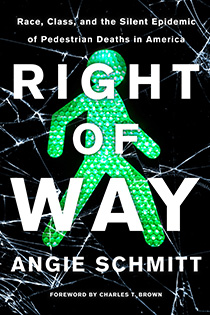When Island Press has a sale, I'm interested, especially if they're $5 each, and even if they're e-books. Founded in 1984 as a non-profit publisher focusing on environmental issues, Island has published some fine works on urbanism, including Cities for People by Jan Gehl (2010) and The Regional City by Peter Calthorpe and William Fulton (2001). I think if I had unlimited time, space, and funds, I might buy their whole catalogue!
Reader, I did not buy their whole catalogue, but I picked a few which speak particularly well to our common lives in these times.
Shane Phillips, The Affordable City: Strategies for Putting Housing Within Reach (and Keeping it There) (Island, 2020).
Phillips addresses the shortage of affordable housing in many of America's cities by taking on what we might call Cortright's Paradox: increasing access to shelter in places with access to opportunities threatens the value of existing housing in those places. (For many households, the home they own is their major investment for retirement.)
Such a complicated problem has not yielded a slam-dunk solution, and Phillips does not pretend that it will. His approach is to seek joint gains for current homeowners, future homeowners, current and future renters, landlords, developers, and local governments. Like Matthew Desmond in Evicted [Crown, 2016], he describes a world not of clear saints and sinners, but all kinds of people mostly trying to do their best in uncertainty. A helpful introduction for non-practitioners is provided in the appendix, "Development and Real Estate Economics 101."
Phillips identifies three broad, complimentary interests: supply of places to live, stability of living situations, and subsidy by government to compensate for market failures. Under these goals he offers 40 specific policy proposals, which is a lot. They aren't a single indivisible package, though he urges governments not to adopt them piecemeal, or only to adopt the ones with particular ideological appeal. Whatever policies are pursued should be done with a joint gains strategy. For example, if housing is going to be a secure investment, it must increase in value, which makes it less and less affordable (pp. 63-64). Allowing the supply to rise to meet demand may reduce the valuation of existing homes, but it will also allow property taxes to remain manageable, and while the owner's descendants may not benefit as much from inheriting it, they will likely benefit more from being able to afford to buy their own homes when the time comes.
Angie Schmitt, Right of Way: Race, Class and the Silent Epidemic of Pedestrian Deaths in America (Island, 2020).
This was a difficult book to read, not because of the writing, which is excellent, but because of the subject matter. I can't imagine the strength of character it took to write it. Schmitt analyzes the available data and secondary sources on the thousands of pedestrian deaths each year, and comes to the inescapable conclusion that America has been willing to put up with carnage on the streets for the sake of unobstructed driving ("throughput," ch. 6) and auto industry profits (ch. 5).
Other research (chs 1-2) shows that pedestrian deaths are not random, but occur disproportionately in the new cities of the South and Southwest, on stroads where auto speeds are fast and pedestrian infrastructure is poor, and in lower-income and nonwhite neighborhoods. Pedestrian deaths are disproportionately caused by sport utility vehicles which are getting taller and heavier and consequently deadlier. (As I was reading this GMC introduced its new 9000 lb Hummer EV.) Older people and children are the most common victims. The picture this book paints of American materialism and indifference to others is bleak indeed.
She concludes on a hopeful note, that thanks to activism there has been increased awareness of the systemic nature of the problem, and that has led to design improvements in some places: better sidewalks, better street lighting, curb ramps, bus stops in safe places, longer traffic signals, more crosswalks with features to get the attention of drivers (p. 154). But even in New York City, the least car-dependent city in America, it required grieving parents to form Families for Safe Streets to get the government's attention. Making this right is going to be a long process.
Patrick M. Condon, 5 Rules for Tomorrow's Cities: Design in an Age of Urban Migration, Demographic Change, and a Disappearing Middle Class (Island, 2019).
Condon combines positivity (we can do this!) with urgency (we must do this!), in view of climate change and persistent economic and demographic trends. His five rules are:
- following Jane Jacobs, see the city not as a set of isolated problems (e.g. solve parking shortage by building more parking lots) but as an integrated and complex system;
- following Christopher Alexander ("A City is Not a Tree," Architectural Forum, 1965), see the city as a "semi-lattice" series of patterns that fail when all are run through the city center;
- make infrastructure lighter, greener, and smarter, because the principal reason we have such a maintenance backlog is that we've been profligate in building the stuff in the first place;
- use affordable housing design that accounts for the need for financing, social resilience, change over time, and accommodating an aging population; and
- adapt to new economic realities "where stagnant salaries are the norm, secure employment increasingly rare, large student loan obligations common, and elevated housing costs nearly universal" (p. 135).
Steven Higashide, Better Buses, Better Cities: How to Plan, Run, and Win the Fight for Effective Transit (Island, 2019).
- frequent, so that a bus will come within 10 minutes (ch. 2);
- fast and reliable, freed from auto traffic and obligated to make fewer stops, so that you can get to your destination in a reasonable and predictable amount of time (ch. 3);
- walkable/dignified, so you can wait in a shelter, and can get safely from your stop to your destination (ch. 4);
- fair/welcoming payment systems, with special attention to marginalized communities (ch. 5).
 |
| The D6 was our "magic bus" when we lived in DC |









No comments:
Post a Comment